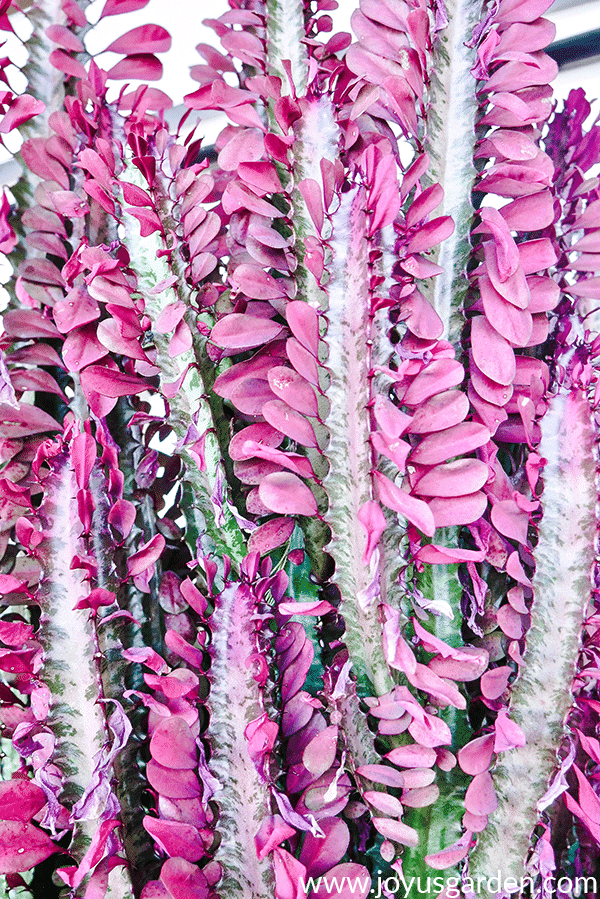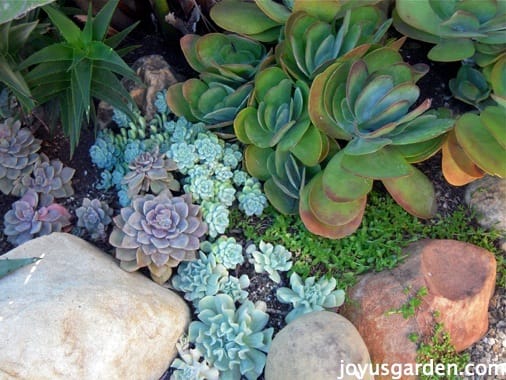How to Prune Succulents
Succulents, like your other houseplants, will grow over time and need to be pruned. Some need little if any pruning and some will require much more, it just depends on the type of succulent and the environment. Whether you’re deadheading, trimming, removing dead leaves, or making more extensive cuts, this guide on how to prune succulents will help you out.
Pruning succulents is easy. They generally don’t need it on a regular basis, maybe once every year or two. How I prune my indoor succulents is the same as how I prune my outdoor succulents. The latter grow faster and need it a bit more often.
Watch the video below to see pruning succulents in action!
NOTE: If you’re interested in seeing how I prune my hanging succulents, you’ll find a video showing this towards the end of the post.
When to Prune Succulents
The best time to prune succulent plants is during the spring and summer months. Early fall is fine too, especially if you live in a climate with warmer winters.
If your succulent breaks or spills over in winter, then by all means prune it. I pruned my large Pencil Cactus in January because it broke during my move in late December.
Otherwise, I do my succulent pruning in spring and summer with the occasional pruning in September and October. I live in Tucson, AZ.
Why Should You Prune Succulents?
There are quite a few reasons to prune them, some of which depend on the type of succulent and how it grows. They include: aesthetics (you want it to grow and look a certain way), to control the overall size, legginess, to thin out, to remove broken or dried stems, to rejuvenate and stimulate new growth, to propagate, to deadhead flowers, or to create bonsai.

Pruning Tools
Pruners, floral snips, scissors, or a knife.
I use my trusty Felco pruners on thicker stems and Fiskar Floral Snips for thin or more delicate stems. I’ve used both of these pruning tools for years and wouldn’t want to be without them.
Whatever you use, make sure your pruning tools are clean and sharp. This ensures a healthy cut (especially if you’re taking cuttings) and lessens the chance of infection.

How to Prune/Trim Succulents
If you’re new to the wonderful world of succulents, it’s best to watch the video and to get a visual idea of how I prune. Succulents you’ll see me prune: Panda Plant, Echeveria, Sedum, String Of Buttons, Jade Plant, and Princess Pine Crassula.
You’ll start by making a clean cut straight across the stem.
Most succulents I know of have nodes which are the points where a leaf or side stem attaches to the main stem. The graphic in the link will illustrate it for you. It’s best to prune 1/4-1/2″ right below a node.
Where you make the cut lengthwise depends on the type of succulent and your purpose for pruning it.
How much you prune off is up to you and the extent of pruning the succulent needs. I sometimes tip prune (pinch off the very end) and only take off an inch or two.
When I recently pruned my Pencil Cactus and Grey Fishhooks, I took off 3′ and 4′ stems. The Pencil Cactus had broken stems and wasn’t able to stand up on its own. Because of the pruning, it doesn’t need to be staked.
In regards to the Fishhooks, pruning was done to control the length, get rid of dead stems, and stimulate new shoots at the top. It grows outdoors on the patio outside my kitchen along with 2 other hanging succulents.
Summer is very hot here in Tucson and fleshy succulents aren’t their happiest at this time of year. They look and do better if the trails are kept shorter.
I’ve done pruning posts on the following succulents: Pencil Cactus, leggy succulents, Christmas Cactus, Burro’s Tail Sedum, Grey Fishhooks Senecio, and Paddle Plant (Flapjacks Kalanchoe).
How to Prune Leggy Succulents
I usually cut succulents down to the point where foliage is more abundant or close to the base to stimulate new growth, depending on how they’re growing. One of my outdoor succulent arrangement pots grew leggy and I cut all of the plants back. You can read about it here.
I propagated all the stem cuttings and replanted them back in the same pot. We want those stem cuttings for new plants after all!

How to Deadhead Succulents
Deadheading succulents is a good idea because nobody wants to look at dead flowers. I wait until all the flowers on the stem die and then remove the stem. Sometimes the stem is dried and sometimes not, you can remove it either way.
Removing dead leaves
Most succulents lose lower leaves as they grow taller or wider, it’s their nature. One you might be familiar with is the popular Hens and Chicks.
It looks much better if you remove them. The dead leaves should pull right off.
If you have a lot of discolored leaves it’s often a sign of improper watering, either too much or too little. This guide on watering succulents indoors will help.
How to Prune Succulents in Pots
I wanted to add this in because this post is about pruning succulents in pots. When I lived in Santa Barbara (an ideal climate for growing fleshy succulents), I had them growing in my front, side, and back gardens.
I pruned my succulents there more often than I do my indoor succulents here in Tucson. They grew much faster. The pruning principles were the same, but the trimmings were in greater quantity. I did it mainly to control size and form.
What to do with Succulent Cuttings
You can either compost them, give them away, or propagate them. Check out this post on propagating succulents 3 simple ways for more details.

Pruning Hanging Succulents
There are a few reasons that I prune trailing succulents. The main one is to control the length and/or denseness.
In Santa Barbara, my hanging succulents grew fast and would oftentimes hit the ground. Here in Tucson, the trails look a bit ratty and dry by the end of summer so I prune them in late spring to combat this. It also stimulates new growth to appear at the top once the summer heat subsides.
A couple of other reasons are to remove dead stems and to propagate.
My trailing succulents all have thinner stems so I use my old standby Fiskars Floral Snips to do the pruning. I like them because they make precise cuts on their delicate stems.
How I trim hanging succulents
FAQs About Pruning Succulents
Yes, especially if they’re spindly or getting too big.
The plants in succulent arrangements are prone to crowding each other out. You may need to prune them, perhaps aggressively, to keep shape and form.
In most cases that I can think of, yes. It’s called tip pruning. What it does is control the height or width and helps the plant to fill in.
Definitely cut them back.
Yes, and you can repot it too. Make sure the cut end of the stem heals over before you plant it. Check the post on succulent propagation for more details.
If your succulents are getting leggy or stretched out, there are a few main reasons: it’s the nature of the succulent and how it grows, it’s reaching for the light source, or the light level overall is too low.
Yes, don’t toss it!
Yes, cut the dead flowers and the stem off. The succulents will look much better with them gone.
Succulents losing lower leaves is part of how succulents grow. If the plant is losing a lot of leaves and they’ve turned yellow, it’s a sign something isn’t right, usually over or under-watering.
Yes indeed.

Pruning and trimming succulents isn’t hard at all. Follow this guide and you’ll get comfortable with it in no time!
Happy gardening,








